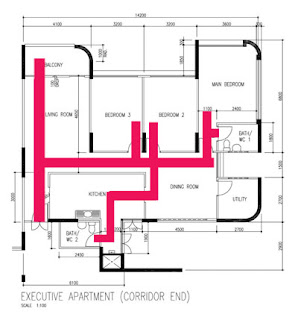Please note that I am only sharing my own experience of DIY buying HDB. I represent no professional body. For more info, you really should study HDB website (I expect someone who DIY is working hard to cut cost).
- Option to Purchase (OTP)
- HDB has a good explanation of how to enter into a contract using OTP
- Most likely you will be requested to write $1000 cheque ($1000 is the max) as option fee
- You will have 14 days to consider whether you still interested to buy
- The seller agent will hand you the OTP form (or you can print from HDB website)
- In fact, this shouldn't consider as your "cooling period" (everyone called this cooling period). Use this few days to settle your financial stuff
- If you are really interested, you should start to engage a bank as soon as possible upon signing the OTP ($1000 is not refundable). Most likely you will able to make it on time
- Before proceeding to exercise, print out the Buyer Resale Checklist and do a good checking and sign on the checklist (take note of the date, it is before exercising). - Exercise OTP
- You can exercise anytime between the point of signing OTP and OTP expiry date
- Exercise the OTP by paying $4000 (most likely you will be requested for max amount)
- Discuss with the seller (or seller agent) for the 1st appointment date (refer to the HDB appointment schedule)
- Two months is standard timing but it always can be faster if there is an empty slot
- The seller agent will submit the seller side application to HDB
- For our case, since we are DIY, we submit application through HDB Resale Net
- Most people will think it is very tedious. In fact, I think it is very easy unless you never fill in online form before
- Just take note of the amount of OTP and exercise fee when filling in the form. This part is always missed by a lot of DIY buyer.
- Look for your lawyer if you are taking bank loan, there are a lot of law firm offering HDB resale service. Remember ask whether the fees are including CPF withdrawal fees. For my case, law firm that I surveyed is cheaper than the firm that was introduced by my banker (you should have guessed so). DIY buyer should understand why. - First Appointment
- Between the application submission date and first appointment date, HDB will send you the documents needed for first appointment.
- Most likely you will have all the documents. Just few documents, please be precise and do follow up enquiry to HDB if you don't understand. You will save $5000 for this.
- For foreigner, this is pretty tricky, you might need to rush back home country for proof document for your private property sale. If you are reading this before this point of time, you can bring these documents before even you look for flat.
- You can go down to the law firm to discuss before your first appointment or discuss after first appointment. It is all about you need to know, money for completion.
- Stamp duty is about $10k (varies from different flat), so you should account this into your budget. Other fees are in smaller amount. Since you have already saved $5000, they should be all right to you.
- At this point of time, it is about to reach 80% of your HDB purchase. I never imagine how easy this is.
- This date you will set the completion date with your seller. Try to do it end of the month or so, it is good for everyone.
- You also can set a date for inspecting the flat before completion. By this date, you have no choice but to accept everything (it is almost useless for this inspection). Be a nice buyer, don't harass your seller with reno contractors. - Completion
- I didn't go down for completion as I am represented by my lawyer. That's because I am taking bank loan.
- You also need to pay the seller back if he/she helped you to pay the property tax.
- Legal fees if you haven't pay.
- You will receive the keys from your lawyer (or HDB).
- That's all, you saved $5000!
I used this page as a reference when I purchase my flat.
Next, the remaining things to settle is changing of address, PUB registration, town council account etc. These are not within the scope of DIY buying HDB.




